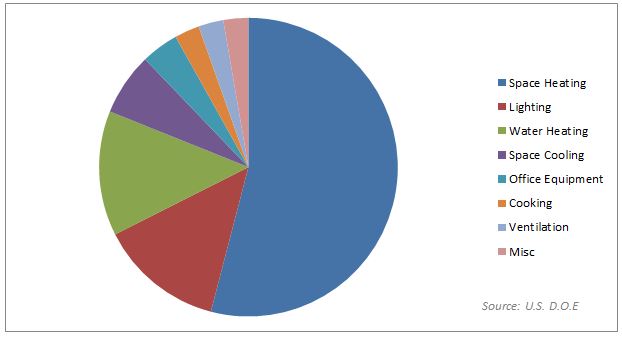industry-news
Local Efficiency Insulation Rebates
May 11, 2021

Energy costs are second only to personnel costs as the leading draw on K-12 school district operating budgets, totaling approximately $8 billion annually nationwide. According to the Environmental Protection Agency, the least efficient schools use three times more energy than the best energy performers.
This chart highlights the top energy costs of schools:

These energy costs can be broken down to per-student terms. Schools spend approximately $75 per student on gas bills and $130 per student on electricity each year.
Many school districts are taking steps to improve the energy efficiency of their school buildings. Along with achieving significant energy cost savings, investing in energy efficiency produces environmental, economic, and educational benefits. This quote sums up why schools should be doing everything they can to save energy:
“Every dollar spent on energy impacts teaching and learning because it takes economic vitality away from the core mission of teaching and learning. For that reason alone, schools should aggressively pursue strategic energy management planning.”
-Roger Young, Principal at Roger Young & Associates, Education Industry Consultant
The first step to reducing energy use in a school is to estimate the potential for improvement. Using tools and reports from a carbon calculator or insulation energy appraisal, schools can acquire benchmark data for how much energy they currently use. This data is critical to setting reasonable goals for improvement.
Once your school has the necessary data and the goals have been set, it becomes easier to create an action plan for how the goals will be achieved. This includes building out a timeline and setting milestones to track progress toward accomplishing the energy saving goals.
Significantly reducing energy use in schools requires everyone in the school community to get on board—school board members, superintendent, administrators, teachers, students and staff. Reducing energy use can come in the form of major facility upgrades, but it can also add up to many smaller behavioral changes among the school building occupants, such as turning off lights and computers when not in use and producing less waste.
The campaign could also include district-wide policy changes in the way schools operate, such as instituting standardized thermostat settings.
One of the most effective ways to launch an energy campaign in your school is to appoint an Energy Manager who reports regularly to school board and superintendent. This person is in charge of making sure the goals are being met and championing the efforts that are leading to success. Having an Energy Manager increases accountability and leads to better results all around.
Sometimes saving money means spending money, and reducing a school’s energy use may require a line in the budget. In the short-term, plan to implement an energy-focused maintenance program. In the long-term, plan on investing in mechanical upgrades or equipment that is more energy-efficient.
Mechanical insulation is one of the simplest and most effective ways schools can begin saving energy. The average school has an energy intensity of approximately 68,700 Btu per square foot. The energy savings due to mechanical insulation in schools have been studied by the National Insulation Association. They found that mechanical insulation saves schools, on average, 13,000 Btu per square foot per year of site energy (about 20 percent of the total usage).
Read more about the energy-saving benefits of mechanical insulation for schools.
According to the EPA, modification of a pre-existing building for energy efficiency, a process known as retrocommissioning, can save a typical 100,000-square-foot school building between $10,000 and $16,000 annually, and simple behavioral and operational measures alone can reduce energy costs by up to 25 percent. It is possible for schools to reduce their energy use. It takes a real commitment and active participation from the school community.